
The vireos make up a family, Vireonidae, of small to medium-sized passerine birds found in the New World and Southeast Asia. "Vireo" is a Latin word referring to a green migratory bird, perhaps the female golden oriole, possibly the European greenfinch.

The forest canary is a species of finch in the family Fringillidae. It is found in South Africa and Eswatini. Its natural habitats are subtropical or tropical moist lowland forest and subtropical or tropical moist montane forest.

The Chinese babax is a species of bird in the family Leiothrichidae. It is found in China, Hong Kong, India, and Myanmar. Its natural habitats are subtropical or tropical moist lowland forests and subtropical or tropical moist montane forests.

The olive flyrobin is a species of bird in the Australasian robin family Petroicidae that is found in New Guinea. Its natural habitat is subtropical or tropical moist lowland forests.

The yellow-legged flyrobin or yellow-legged flycatcher is a species of passerine bird in the Australasian robin family Petroicidae. It is found in New Guinea and Cape York Peninsula. Its natural habitats are subtropical or tropical moist lowland forest and subtropical or tropical moist montane forest.

The capuchin babbler is a species of bird in the family Leiothrichidae.

The pied shrike-babbler is a bird species traditionally considered an aberrant Old World babbler and placed in the family Timaliidae. But as it seems, it belongs to an Asian offshoot of the American vireos and may well belong in the Vireonidae. Indeed, since long it was noted that their habits resemble those of vireos, but this was believed to be the result of convergent evolution.

The shrike-babblers are a group of small birds in the genus Pteruthius. They are native to the Indomalayan realm, and were traditionally placed in the family Timaliidae before molecular phylogenetic studies in 2007 found that they were best considered as belonging to the family Vireonidae which was then thought to be restricted to the New World. They were traditionally classified into five species with several subspecies but changes in the status of these species on the basis of the phylogenetic species concept suggest more forms in a cryptic species complex. Most species are found in montane forests, with some species descending down to lower altitudes during the winter.
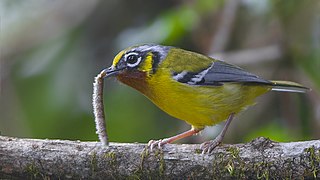
The black-eared shrike-babbler is a bird species in the vireo family, Vireonidae. It was traditionally considered as an aberrant Old World babbler and formerly placed in the family Timaliidae. It was long noted that their habits resembled those of vireos, but this was previously ascribed to the result of convergent evolution. It is found in Southeast Asia from the Himalayas to western Malaysia. Its natural habitat is subtropical or tropical moist montane forests.

The black-headed shrike-babbler is a bird species traditionally placed with the Old World babblers in the family Timaliidae. However, it might be one of the few Eurasian vireos (Vireonidae).

The green shrike-babbler is a bird species that was earlier placed in the family Timaliidae. The species is now considered to be an Asian offshoot of the American vireos and belongs in the family Vireonidae.

The Sikkim wedge-billed babbler or blackish-breasted babbler is a species of bird in the Old World babbler family (Timaliidae). It is named for the Indian state of Sikkim.

The slender-billed scimitar babbler is a passerine bird in the Old World babbler family. It is found from the Himalayas to north-western Vietnam. Its natural habitat is subtropical or tropical moist montane forests.

The white-bellied erpornis or simply erpornis is a species of bird. It is the only member of the genus Erpornis. This bird is found in Bangladesh, Bhutan, Brunei, Cambodia, China, India, Indonesia, Laos, Malaysia, Myanmar, Nepal, Singapore, Taiwan, Thailand, and Vietnam. Its natural habitat is subtropical or tropical moist montane forests.
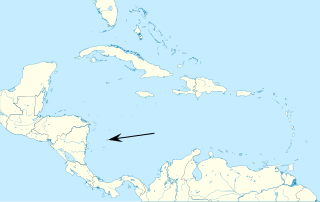
The Providencia vireo is a species of bird in the family Vireonidae. It is endemic to Isla de Providencia. Its natural habitats are subtropical or tropical moist lowland forests, subtropical or tropical moist montane forests, plantations, and heavily degraded former forest. It is threatened by habitat loss. It is sometimes considered a subspecies of the thick-billed vireo.

The trilling shrike-babbler is a species of bird in the family Vireonidae. It is endemic to the island of Java. Its natural habitats are subtropical or tropical moist lowland forests and subtropical or tropical moist montane forests. It used to be considered the nominate subspecies of the chestnut-fronted shrike-babbler.
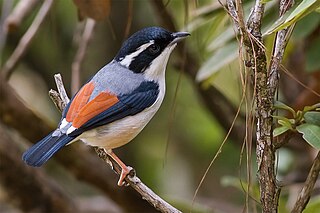
The Himalayan shrike-babbler is a bird species found in the western Himalayas that belongs to the shrike-babbler group. The genus was once considered to be an aberrant Old World babbler and placed in the family Timaliidae until molecular phylogenetic studies showed them to be closely related to the vireos of the New World, leading to their addition in the family Vireonidae. Males and females have distinctive plumages, with the males being all black about with a cinnamon-rufous tertial patch and a distinctive white stripe running from behind the eye. The underside is whitish with some pinkish buff on the flanks. Females have a greyish head, lack the white stripe and have the upperparts and wings with greens, yellow and chestnut. The species is part of a cryptic species complex that was earlier considered as one species, white-browed shrike-babbler with several subspecies.

Blyth's shrike-babbler is a bird species found in the eastern Himalayas and Southeast Asia from northern Burma to southern Cambodia. Like others in the genus it is found in montane forests. Males and females have different plumages and variations occur through its range with several populations being treated as subspecies. It is part of a cryptic species complex and was earlier lumped as a subspecies of the white-browed shrike-babbler.
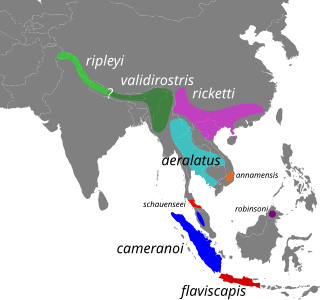
The Dalat shrike-babbler is a bird species traditionally considered an aberrant Old World babbler and placed in the family Timaliidae. But as it seems, it belongs to an Asian offshoot of the American vireos and may well belong in the Vireonidae. Indeed, since long it was noted that their habits resemble those of vireos, but this was believed to be the result of convergent evolution.
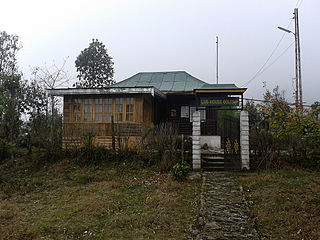
Fambong Lho Wildlife Sanctuary is a 51 km2 (20 sq mi) large wildlife sanctuary in East Sikkim district of the state of Sikkim in India. It is contiguous with Khangchendzonga National Park and located around 30 km (19 mi) west of Gangtok. It hosts a few small hamlets inside, namely Dikchu, Pangthang, and Mangan and is managed by State Forest Department.



















